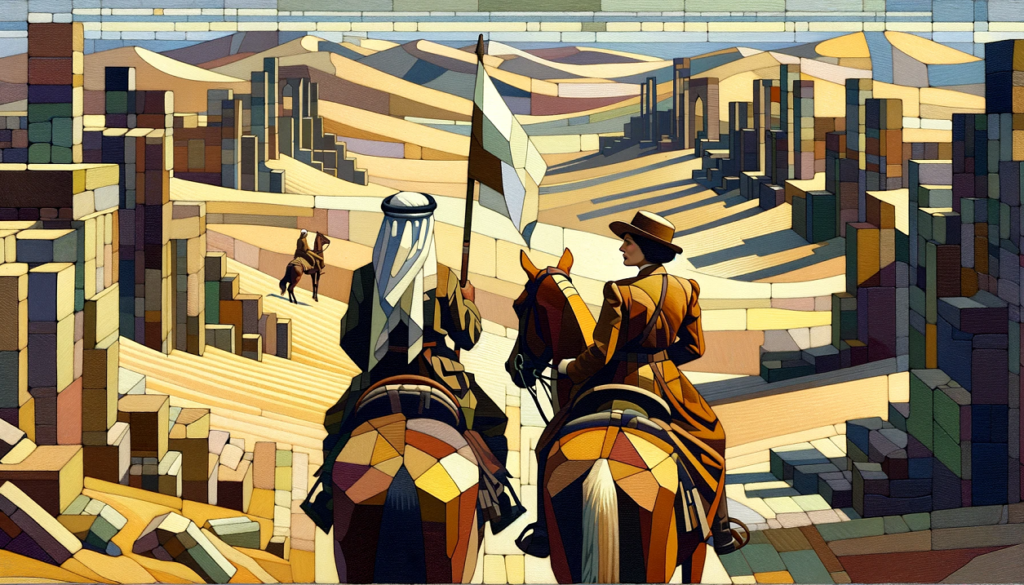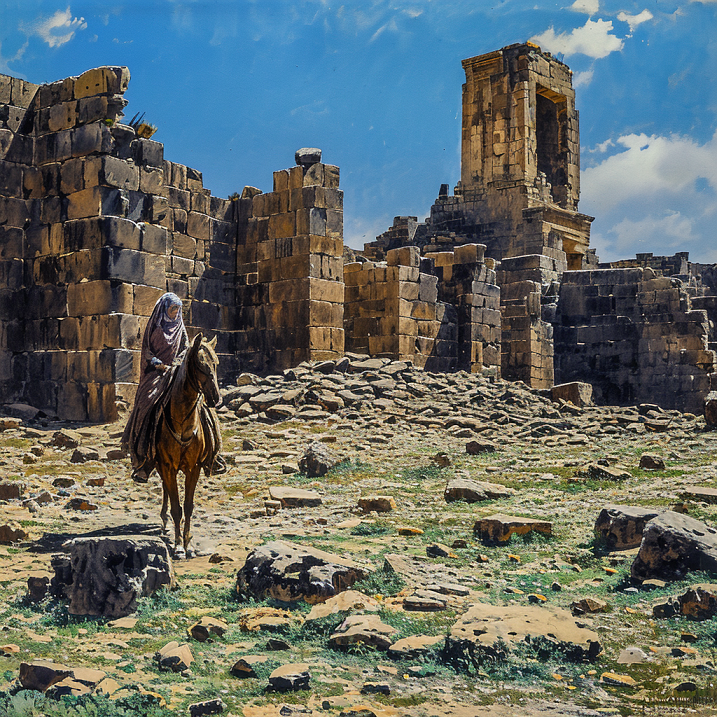Gertrude Bell, a remarkable British explorer, archaeologist, and writer, left a profound legacy within Arabian travel literature. Amongst her many adventures and explorations throughout the region, one intriguing destination was the archaeological site of Umm Al Jimal in Jordan. In her compelling narrative “The Desert and the Sown,” Bell provides unique insights into her visit to this ancient site, shedding light on her experiences and discoveries amidst the captivating ruins of Umm Al Jimal.
As part of their journey through the enigmatic desert regions of Jordan, Gertrude Bell and her fellow explorers path led them into a stark and unforgiving landscape, where the soft desert soil gave way to an unbroken expanse of barren, black volcanic rocks.
The volcanic rocks, a testament to the geological forces that had shaped this land over millennia, seemed to stretch on endlessly. The explorers navigated through the sinuous contours of ancient lava flows, their progress punctuated by the jagged and unyielding terrain beneath their feet. The absence of familiar markers or signs of human presence lent an eerie and desolate quality to their surroundings.
Umm Al Jimal: A Sinister Reputation
Umm Al Jimal had acquired a dark and ominous reputation, one that had intrigued and concerned the explorers. It was a location where few Europeans had ventured, and their camp marked only the second such European presence in the area. The first had been a party of American archaeologists who had left the region just a fortnight before Bell’s arrival.
Gablan, their experienced guide, had initially expressed reservations about camping in Umm Al Jimal. The place carried an air of foreboding, and he had been wary of its reputation. However, Bell’s determination to explore and her assurance of the necessity to find water for their animals prevailed.
Now Umm Al Jimal has an evil name…Gablan’s evident anxiety enhanced its sinister reputation. Twice he turned to me and asked whether it wore necessary to camp there. I answered that he had undertaken to guide me to Umm Al Jimal, and that there was no question but that I should go, and the second time I backed my obstinacy by pointing out that we must have water that night for the animals, and that there was little chance of finding it except in the cisterns of the ruined village.
Gertrude Bell: The desert and the Sown 1907
With the need for water pressing upon them, they consulted their map, seeking to determine their location and the direction in which they should proceed. Awestruck by the sheer desolation and the sense of isolation that surrounded them, they realised that their journey was taking them deeper into the heart of the unknown.
The transition from the desert plains to the volcanic rocks of the Hauran region marked a pivotal moment in their journey. It represented a shift from the familiar landscapes of the desert to the uncharted territories of the Druze Mountain, where their encounters, challenges, and discoveries would take on a new dimension. With their resolve firmly set, the explorers continued their march toward Umm Al Jimal, driven by curiosity, necessity, and the allure of the unknown.
Approaching Umm Al Jimal
As Gertrude Bell and her companions entured deeper into the arid landscape, their attention was drawn to rising ground crowned with sheepfolds. This peculiar sight hinted at the presence of human activity in this remote expanse of desert. As they neared the elevated terrain, a sense of anticipation and curiosity began to take hold.
Alarming Sight of Gathering Men
Their curiosity was soon met with a sight that caught them by surprise. Men were hastily gathering their flocks together, displaying an unmistakable sense of alarm in their hurried movements. It was evident that something had disturbed the tranquillity of this isolated desert region.
Adding to the intrigue were shadowy figures on the horizon, approaching from a hollow to the left. The nature of these figures, whether they were mounted or on foot, remained shrouded in uncertainty. Suddenly, two puffs of smoke rose in the distance, accompanied by the distinct crack of rifles. The tension in the air was palpable as this unexpected turn of events unfolded before them.
“ Darabuna ! ” he said. “ They have fired on us.” I said aloud : “ They are afraid,” but to myself, We’re in for it.” Gablan rose in his stirrups, dragged his fur lined cloak from his shoulders, wound it round his left arm and waved it above his head, and very slowly he and I paced forward together. Another couple of shots were fired, and still we rode forward, Gablan waving his flag of truce.
Gertrude Bell: The desert and the Sown 1907

A False Alarm
Despite the initial alarm caused by the gunfire, it soon became apparent that the firing was not a hostile act but rather a customary greeting to strangers. The tension eased as their assailants, revealed to be two grinning Arabs, were more than willing to fraternise once they realised that Bell and Gablan were not intent on sheep stealing.
Exploring Umm Al Jimal
As Gertrude Bell and Gablan ventured deeper into the heart of the desert, they could hardly believe their eyes when they finally rounded the tell and saw Umm Al Jimal before them. The black towers and walls of this ancient city stood boldly against the desert backdrop, defying the passage of time. It was an astonishing sight, made even more remarkable by the fact that this city had been in ruins and deserted for over thirteen centuries.
After their dramatic entrance into the enigmatic city of Umm Al Jimal, Gertrude Bell’s insatiable curiosity led her to explore its surroundings further. Her keen interest in archaeology drew her to the remarkable Nabatean necropolis that lay just outside the city walls. It was here that her passion for uncovering the mysteries of the past found fertile ground.
Five years prior to Bell’s visit, Monsieur Dussaud, France’s leading Middle East archaeologist and epigrapher, had commenced archaeological excavations in the area. His pioneering efforts laid the foundation for the exploration of this desert necropolis. His work was a testament to the enduring allure of history, as he sought to unveil the secrets hidden beneath the sands of time.
Upon surveying the tombs uncovered by her predecessors and noting several mounds that hinted at the presence of more hidden treasures, Bell sent away her companions, choosing to wander alone in the fading daylight through the ruined streets of the city.
In her quest to uncover the past, Gertrude Bell felt a compelling need to record her discoveries. Yet, acknowledging that more seasoned scholars had already embarked on this path, she gracefully packed away her tools. Her encounters, rich in historical significance, would later be expertly detailed in Gertrude Bell’s literary works, complementing the efforts of the American expedition renowned for their precise archaeological methods. This collaboration underscored the importance of her contributions to the broader tapestry of historical and archaeological scholarship.

Umm Al Jimal and its surroundings had witnessed the passage of time, from the Nabatean era to the days of pagan Rome, and finally, the Christian period. The once thriving city had seen its heyday during this Christian era, but the arrival of the Islamic forces marked a turning point, leading to centuries of desertion.
Umm Al Jimal Quick Facts
Location: Umm Al Jimal is an ancient archaeological site located in northern Jordan, in the province of Irbid.
Nabatean Origins: The site’s history dates back to the Nabatean period, making it an essential part of the region’s historical heritage.
Roman and Byzantine Occupation: Umm Al Jimal flourished during the Roman and Byzantine periods, with evidence of well planned urbanization and construction.
Limestone Buildings: The site is known for its distinctive limestone structures, including houses, churches, and public buildings.
Urban Layout: Umm Al Jimal’s urban layout features a grid pattern of streets, typical of Roman city planning, with well organized residential and commercial areas.
Churches: Several churches have been discovered within the site, showcasing early Christian architecture and religious significance.
Inscriptions: Numerous inscriptions in Greek and Arabic have been found at Umm Al Jimal, shedding light on the languages and cultures that once thrived here.
Abandonment and Desertion: The site was gradually abandoned over the centuries, and its decline was accelerated during the Islamic period.

